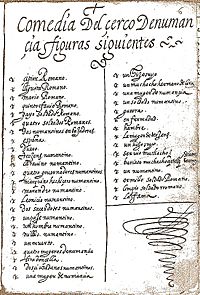The Siege of Numantia facts for kids
The Siege of Numantia (Spanish: El cerco de Numancia) is a play written by Miguel de Cervantes. It is a tragedy, which means it tells a sad story. The play is about a real historical event: the siege of Numantia. This was a time when the Roman army attacked and destroyed the city of Numantia in Spain in 133 BC.
Cervantes wrote this play around 1582. It was quite popular before another famous playwright, Lope de Vega, became well-known. The play has four parts, called "acts" or jornadas. The characters speak in different types of poetry. For a long time, the play was not printed. It was finally published in the 1700s. Many people now see it as a very important Spanish tragedy.
Contents
What is the play about?
The Roman Army Arrives
In the first act, the Roman general Scipio Aemilianus is with his army outside Numantia. He explains that this war has lasted for many years. The Roman leaders sent him to finish the fight. Scipio tells his soldiers they need to focus on fighting. He wants them to be brave and not get distracted. The soldiers feel inspired again.
People from Numantia come to offer peace. But the Romans say no to their offers. In this play, Cervantes uses special characters called "allegories." These are ideas or places shown as people.
Spain and the River Duero
The character of Spain appears. She calls upon the Duero River, which flows by Numantia. An old river god appears with other smaller river gods. These characters try to find out what will happen to Numantia. They learn that the city cannot be saved. This part of the play talks about Spain's past and future. It also makes people think about how empires grow.
Life Inside Numantia
In the second act, the story moves inside Numantia. The city's leaders meet to decide what to do. They make brave choices to defend their city. The play also shows the love story of a young Numantian named Marandro and a girl named Lira.
The people prepare a special ceremony. But during the ceremony, a bad spirit appears. It grabs the animal meant for sacrifice and puts out the fire. This makes everyone in the city even more confused and scared. A dead man is brought back to life using magic. This scene is like an old story from a Roman poem.
A Difficult Choice for Numantia
In the third act, all hope for peace is gone. The men of Numantia want to fight the Romans outside the city. They would rather die fighting than starve during the siege. But the women of the city stop them from doing this. The women encourage a leader named Theagenes to make a very hard decision. This choice leads to the sad ending of the play.
The people of Numantia decide to burn all their valuable things. They also decide to make sure no one becomes a Roman slave. This act shows great patriotism and sadness. Hunger is a big problem in Numantia. Marandro and his friend Leoncio try to sneak into the Roman camp.
The Tragic End
The fourth act shows the sad ending. Marandro returns with some blood-stained bread for Lira. But he falls down, badly hurt. This shows how much the Numantians sacrificed. The allegorical characters of War, Sickness, and Hunger appear on stage. They show how terrible the situation is.
The play ends with the character of Fame appearing. She announces that Spain will become a great power in the future. She says Spain will rise from the ashes of Numantia, just like a phoenix.
See also
 In Spanish: Numancia (Cervantes) para niños
In Spanish: Numancia (Cervantes) para niños


